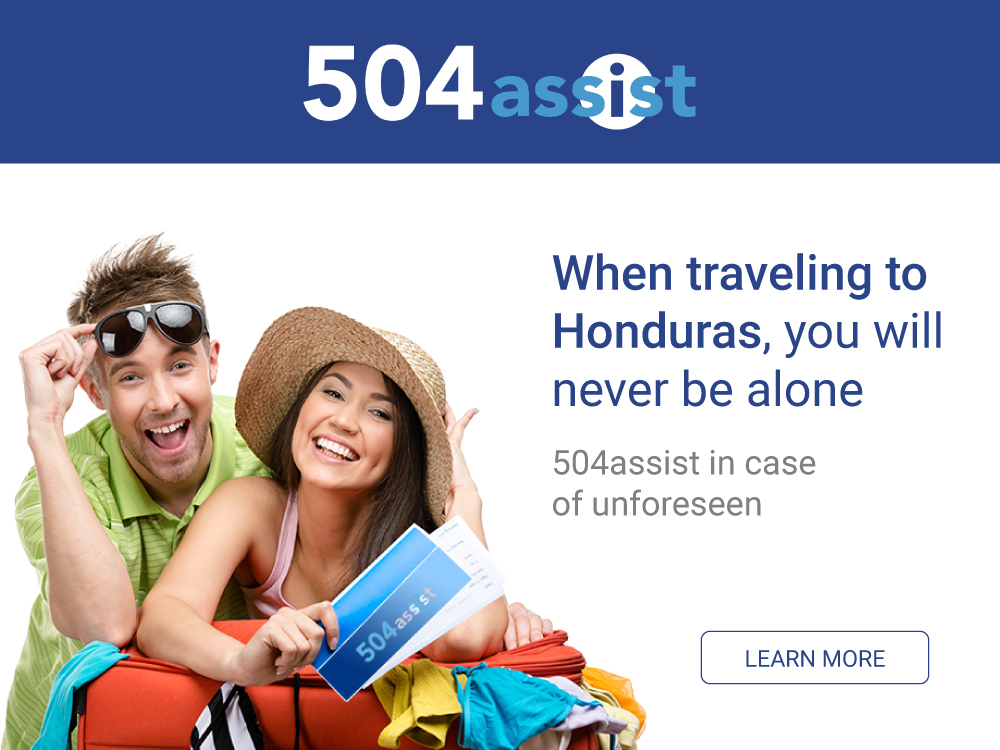Information
Find the most important information about starting your adventure to Honduras.
Roatán
Before traveling to Honduras remember:
504 Assist Tourist Insurance
The 504 Assist insurance can be used by any natural person or foreigner who enters Honduran territory by commercial carrier air flight. It can also be used by any Honduran or foreign resident leaving Honduran territory to go abroad. It is valid for 30 days from the date of entry or exit from the country.
- To register:
- Calls from Honduras, dial the numbers 177 or 2276-3780
- Calls from outside of Honduras, dial number +504 2276-3780
- Website:
- 504assist.com
International Airports
- Tegucigalpa (TGU):
- Toncontín International Airport
- San Pedro Sula (SAP):
- Ramón Villeda Morales International Airport
- La Ceiba (LCB):
- Golosón International Airport
- Roatán, Bay Islands (RTB):
- Juan Manuel Gálvez International Airport
Important: Every traveler leaving Honduran territory must pay an airport charge not included in your airfare. Airport Fees at: www.interairports.hn
Visa|Passport
You might only need your passport to visit Honduras. Check the entry requirements for citizens of your country. Citizens of Spain and the European Union do not require a visa to enter Honduras. They can remain within the Central American territory as tourists for a three-month period.
Other nationalities may require visas. Information at: cedturh.iht.hn
Exchange rate
The official currency in Honduras is the Lempira (L). Its name commemorates the Cacique Lempira, an indigenous leader of the lenca ethnic group who defended his territory during the Spanish conquest. The official exchange rate is set every day by the Central Bank of Honduras (Banco Central de Honduras). You can consult it in this link: www.bch.hn
You can exchange dollars and euros, to a lesser extent, in some stores (banks and hotels receive both currencies). You can use your Visa, Master Card and American Express credit cards in many places, and there are ATM networks with ample national coverage.
Vaccines
If you’re traveling from Argentina, Bolivia, Brasil, Colombia, Ecuador, Guyana, French Guiana, Panamá, Paraguay, Perú, Surinam, Trinidad and Tobago or Venezuela, you must first get vaccinated against yellow fever.
Also if you’re coming from Angola, Benin, Burkina Faso, Burundi, Cameroon, Central African Republic, Chad, Congo, Equatorial Guinea, Ethiopia, Ivory Coast, Democratic Republic of the Congo, Gabón, Gambia, Ghana, Liberia, Mali, Mauritania, Guinea, Guinea Bissau, Kenya, Nigeria, Sierra Leone, Senegal, Somalia, Sudán, Tanzania, Uganda, Nigeria, Rwanda, São Tomé and Príncipe or Togo.
For more information about the vaccines required to enter Honduras, click here: www.embahonduras.es
Weather
The weather in Honduras has a privileged temperature throughout the year, with an average of around 25 degrees Celsius. However, it only has two marked seasons: a dry season, that begins on November and ends between April and May, and a rainy season, that centers on the months of May, June, July, September and October.
Location
Honduras has a privileged location: it is the heart of Central America. To the north is the Caribbean Sea, with extensive beaches and the second greatest barrier reef in the world. To the south is the Pacific Ocean, with a black sand gulf that embraces calm waters. Its neighboring countries are Guatemala, El Salvador and Nicaragua. Its mostly mountainous territory contributes to the weathers’ diversity and the rich and extensive flora and fauna that characterize this tropical country.
Measurements
You’ll find a combination of systems of measurement, although the metric system is predominant. You’ll see that weight is also measured in pounds, liquids in gallons and areas in “manzanas” (approximately 1.72 acres). Heat is expressed in Celsius or centigrade and electricity reaches with 110 VAC 60Hz through flat parallel pin outlets, and, more often every day, in polarized outlets (3 pins).
ABOUT THE ATTRACTIONS
Beach and sun
Visiting the beaches in Honduras is an experience unlike any other. The country has a wide range of beaches for all tastes, from white sandy beaches to beaches of dark sand, bathed by the warm waters of the Caribbean or the agitated waters of the Pacific.
Adventure
Honduras has about 91 Protected Areas that correspond to 27% of the national territory. It has great diversity of flora, with more than 64 plant ecosystem varieties, and of fauna, among which the Guacamaya or Guara Roja, the National Bird of the country, stands out.
Archaeology
Honduras is a territory with archaeological wealth in almost all of its departments. However, it is in Copán, the Sula Valley, Intibucá, La Paz and Olancho where most archaeological sites are located. There are more than 140,000 sites of archaeological interest that are still not registered.
Birdwatching
754 bird species have been documented in Honduras to date, and there are at least 50 others sighted. There is a rich birdlife, with many species endemic to Mesoamerica that live amongst the unique mix that furrows and makes its home in the country.
Gastronomy
Tourist areas have restaurants serving international cuisine and American style dishes. Honduran gastronomy is very varied, since it has pre-Columbian, Spanish, Creole and, to some extent, African elements, as is typical throughout the Atlantic coast of Central America.
Colonial Cities
During the more than 300 years that the colonial period lasted, Spanish presence was manifest in all daily life activities. Now, Honduras is the country with the second greatest tangible colonial heritage in all of Central America.








